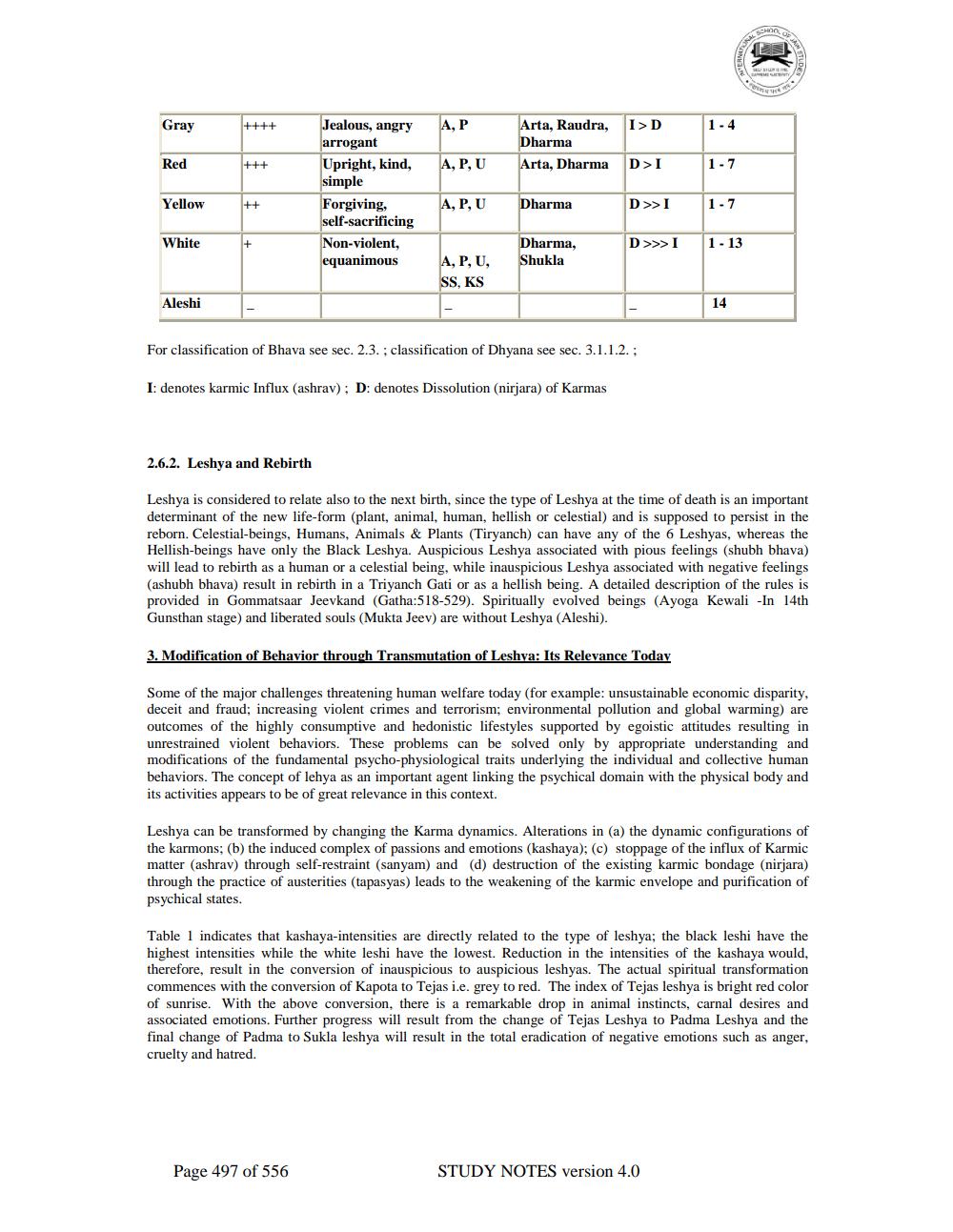________________
Gray
++++
AP
I>D
1-4
Arta, Raudra, Dharma Arta, Dharma
Red
+++
A, P, U
D>I
1-7
Jealous, angry arrogant Upright, kind, simple Forgiving, self-sacrificing Non-violent, equanimous
Yellow
++
A, P, U
Dharma
D>>I
1-7
White
+
D>>>I
1 - 13
Dharma, Shukla
A, P, U, SS, KS
Aleshi
For classification of Bhava see sec. 2.3.; classification of Dhyana see sec. 3.1.1.2.:
I: denotes karmic Influx (ashrav): D: denotes Dissolution (nirjara) of Karmas
2.6.2. Leshya and Rebirth
Leshya is considered to relate also to the next birth, since the type of Leshya at the time of death is an important determinant of the new life-form (plant, animal, human, hellish or celestial) and is supposed to persist in the reborn. Celestial-beings, Humans, Animals & Plants (Tiryanch) can have any of the 6 Leshyas, whereas the Hellish-beings have only the Black Leshya. Auspicious Leshya associated with pious feelings (shubh bhava) will lead to rebirth as a human or a celestial being, while inauspicious Leshya associated with negative feelings (ashubh bhava) result in rebirth in a Triyanch Gati or as a hellish being. A detailed description of the rules is provided in Gommatsaar Jeevkand (Gatha:518-529). Spiritually evolved beings (Ayoga Kewali -In 14th Gunsthan stage and liberated souls (Mukta Jeev) are without Leshya (Aleshi).
3. Modification of Behavior through Transmutation of Leshya: Its Relevance Today
Some of the major challenges threatening human welfare today (for example: unsustainable economic disparity, deceit and fraud; increasing violent crimes and terrorism; environmental pollution and global warming) are outcomes of the highly consumptive and hedonistic lifestyles supported by egoistic attitudes resulting in unrestrained violent behaviors. These problems can be solved only by appropriate understanding and modifications of the fundamental psycho-physiological traits underlying the individual and collective human behaviors. The concept of lehya as an important agent linking the psychical domain with the physical body and its activities appears to be of great relevance in this context.
Leshya can be transformed by changing the Karma dynamics. Alterations in (a) the dynamic configurations of the karmons; (b) the induced complex of passions and emotions (kashaya); (c) stoppage of the influx of Karmic matter (ashrav) through self-restraint (sanyam) and (d) destruction of the existing karmic bondage (nirjara) through the practice of austerities (tapasyas) leads to the weakening of the karmic envelope and purification of psychical states.
Table 1 indicates that kashaya-intensities are directly related to the type of leshya; the black leshi have the highest intensities while the white leshi have the lowest. Reduction in the intensities of the kashaya would, therefore, result in the conversion of inauspicious to auspicious leshyas. The actual spiritual transformation commences with the conversion of Kapota to Tejas i.e. grey to red. The index of Tejas leshya is bright red color of sunrise. With the above conversion, there is a remarkable drop in animal instincts, carnal desires and associated emotions. Further progress will result from the change of Tejas Leshya to Padma Leshya and the final change of Padma to Sukla leshya will result in the total eradication of negative emotions such as anger, cruelty and hatred.
Page 497 of 556
STUDY NOTES version 4.0




